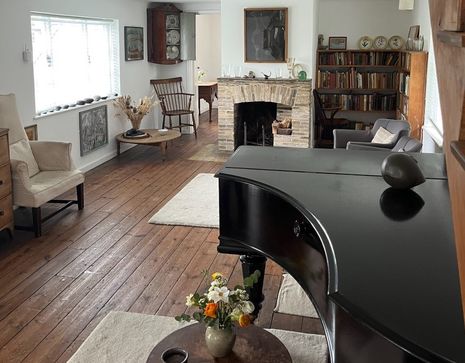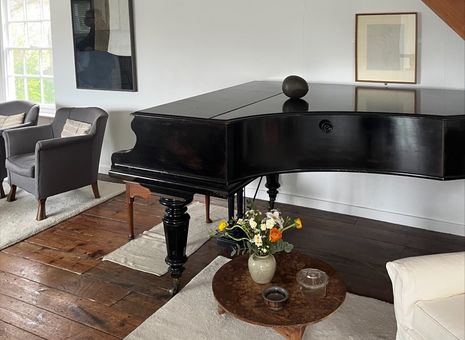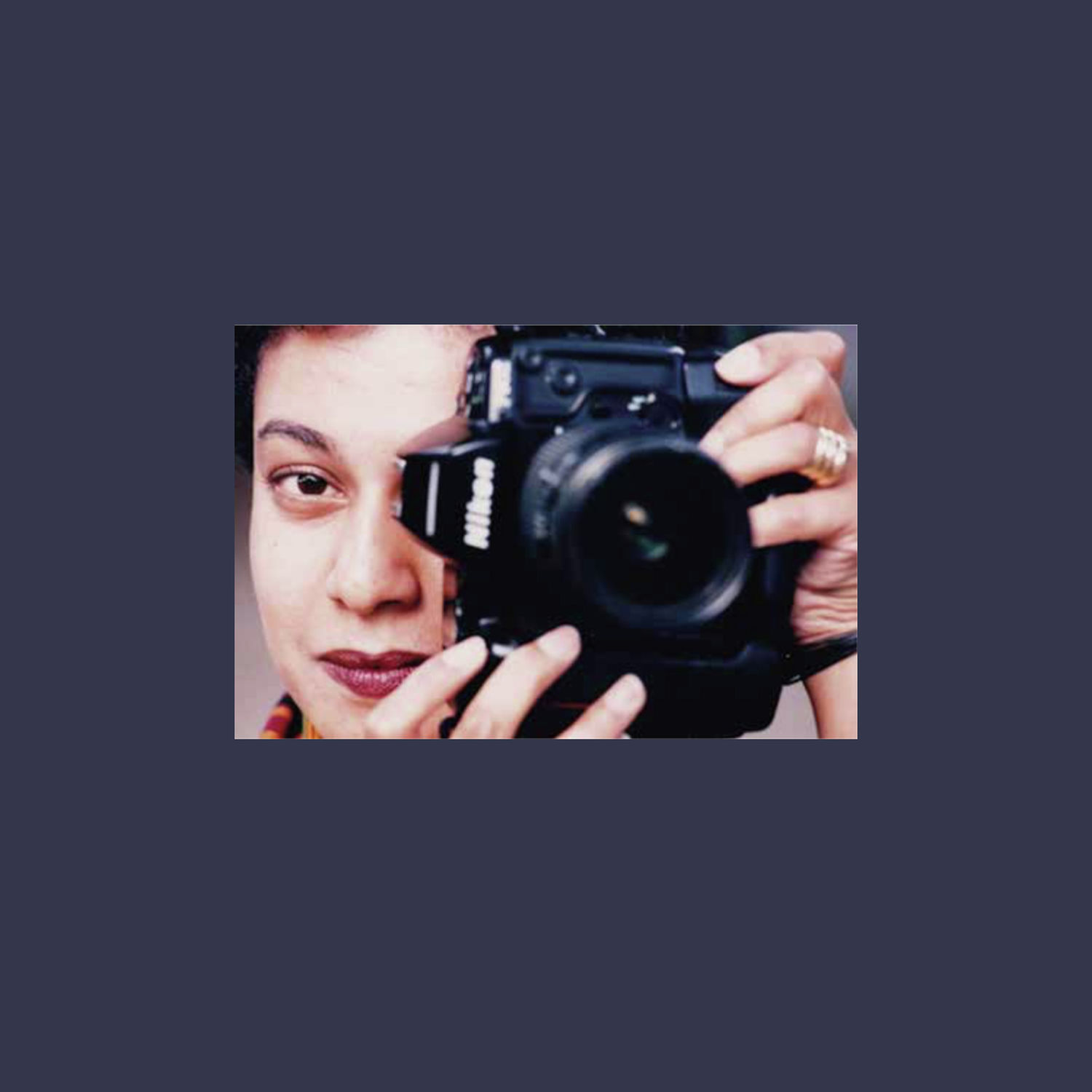Brâncuși in Kettle’s Yard
Margaux Emmanuel experiences the contemporary art gallery’s collection of works from Romanian artist Constantin Brâncuși

In the midst of the late Jim Ede’s salon in Kettle’s Yard stands a grand piano. Atop the dark and glossy lid of the majestic instrument lies a reclining sculpted head, only its oval-like form hinting at humanity, as features subtly dimple the cement cast. The work, a cement cast of Romanian artist Constantin Brâncuși’s ‘Prometheus’ (1912), seems to float atop the smooth, dark mass of the piano. Jim Ede acquired Brâncuși’s works after corresponding with him. There is an inherent tragedy to this isolated head, severed from a body, its features effaced, a stoney coldness merged with the white back wall and the black lid it seems to sink into.
But there’s also a peacefulness to it, as if the head were sleeping, conferring a dream-like quality to the oeuvre. Jim Ede’s irony of placing Brâncuși’s ‘Prometheus’ is palpable; like its mythological inspiration, its stoney immutability and a sense of visual heaviness will not allow it to go anywhere– this metaphorical rendition of the tragedy of modern man casually rests on the piano like a mere book rest. Kettle’s Yard House itself appeals to the imaginary– in its architecture (its disposition prompting the ‘it’s like the tardis!’ of a dazed visitor), as the house unfolds room after room, its visitors descending staircases only to ascend another. This space also violates our experience of the typical museum, as a Miró hangs in the dining room, or Alfred Wallis’s oeuvres decorate the walls.
Happy Birthday to Constantin Brancusi, born #OTD 1876. "Torso of a Young Man" is on view! https://t.co/5tkrG38MdT pic.twitter.com/fipaCnAysW
- Hirshhorn (@hirshhorn) February 19, 2016
As Kettle’s Yard plunges the viewer of these oeuvres in a liminal space, the House also displays Brâncuși’s drawings and sketches, a rare occurrence as the artist mostly used clay and plaster to experiment and ‘sketch out’ his work. We can find the outlines of a leaning woman in ‘Nude’ (c.1906) said to bear resemblance to his sculpture created a decade or so later ‘Torso of a Young Man’ (c.1917-1922), now displayed in the Brodsky Gallery of the Philadelphia Museum of Art. The ‘Torso’ is made of three wooden cylinders. Brâncuși wished to attain the ‘essence’ of things, creating a true upheaval in the artistic world – ‘Prometheus’’s simplicity and purity to a geometrical precision, also emerges in ‘Torso of a Young Man’. As ‘Prometheus’ lies on Jim Ede’s piano, it also testifies to a radical departure from any sort of sculptural realism, undoubtedly inspired by Rodin’s truncation of the human form in works such as ‘The Inner Voice’ (1966). Even though Brâncuși was never officially affiliated with any specific sculptural movement, the artists he spent time with in Paris were deeply immersed in the Parisian avant-garde movement; he met artists such as Marcel Duchamp, Henri Matisse, or Fernand Léger.
"As ‘Prometheus’ lies on Jim Ede’s piano, it also testifies to a radical departure from any sort of sculptural realism"
As man becomes an abstraction, forms are rationalised, surfaces made clear and smooth, conveying an immediacy to Brâncuși’s creative syntax. One of the artist’s aphorisms ‘When we are no longer like children, we are already dead’ reflects this– in retrospect, this conception of being ‘already dead’ can be considered to be a very pre-Foucauldian thought when considering his argument in The Order of Things ‘it is comforting, however, and a source of profound relief to think that man is only a recent invention, a figure not yet two centuries old, a new wrinkle in our knowledge, and that he will disappear’– but this also underlines Brâncuși’s appeal to the imaginary with the idea of remaining child-like. The artist works with this idea of the death of man, as he sculpts isolated limbs, in a way dehumanising the body. And yet, he asks us to remain childish in spirit.

In the lower extension of the house, we can find the 1969 posthumous cast of ‘Golden fish’ (1924), a cut of brass reflecting on a steel plate; unlike the weighty reflection of ‘Prometheus’ on the sleek piano top, the glass-like effect of ‘Golden fish’ creates a sense of airy lightness in its transparency, the floating goldfish impression in its fish bowl. The fish’s shapes are radicalised with a slab of brass, its copper-coloured reflections in the light hinting at this ‘golden fish’: abstraction meets the natural world.
Jim Ede strived to confer a consciously immersive artistic experience through the disposition of artwork in his house– Brâncuși’s sketches and sculptures are no exception, as ‘Prometheus’, ‘Nude, and ‘Golden Fish’ not only very well represent his own artistic imaginary, but also appeal to that of the wandering visitor of Kettle’s Yard.
 News / Clare Hall spent over £500k opposing busway 24 December 2025
News / Clare Hall spent over £500k opposing busway 24 December 2025 Comment / The ‘class’ of Cambridge24 December 2025
Comment / The ‘class’ of Cambridge24 December 2025 News / Caius mourns its tree-mendous loss23 December 2025
News / Caius mourns its tree-mendous loss23 December 2025 News / Girton JCR publishes open letter expressing solidarity with Palestine25 December 2025
News / Girton JCR publishes open letter expressing solidarity with Palestine25 December 2025 Comment / Yes, I’m brown – but I have more important things to say22 December 2025
Comment / Yes, I’m brown – but I have more important things to say22 December 2025










